Quarkus is a framework for building Java applications in times of microservices and serverless architectures. If you compare it with other frameworks like Spring Boot / Spring Cloud or Micronaut, the first difference is native support for running on Kubernetes or Openshift platforms. It is built on top of well-known Java standards like CDI, JAX-RS, and Eclipse MicroProfile which also distinguishes it from Spring Boot or Micronaut. Continue reading “Quick Guide to Microservices with Quarkus on Openshift”
Tag: Swagger2
Micronaut Tutorial: Server Application
In this part of my tutorial to Micronaut framework we are going to create simple HTTP server-side application running on Netty. We have already discussed the most interesting core features of Micronaut like beans, scopes or unit testing in the first part of that tutorial. For more details you may refer to my article Micronaut Tutorial: Beans and Scopes.
Assuming we have a basic knowledge about core mechanisms of Micronaut we may proceed to the key part of that framework and discuss how to build simple microservice application exposing REST API over HTTP. Continue reading “Micronaut Tutorial: Server Application”
Quick Guide to Microservices with Spring Boot 2.0, Eureka and Spring Cloud
There are many articles on my blog about microservices with Spring Boot and Spring Cloud. The main purpose of this article is to provide a brief summary of the most important components provided by these frameworks that help you in creating microservices and in fact explain you what is Spring Cloud for microservices architecture. The topics covered in this article are:
- Using Spring Boot 2 in cloud-native development
- Providing service discovery for all microservices with Spring Cloud Netflix Eureka
- Distributed configuration with Spring Cloud Config
- API Gateway pattern using a new project inside Spring Cloud: Spring Cloud Gateway
- Correlating logs with Spring Cloud Sleuth
Before we proceed to the source code, let’s take a look on the following diagram. It illustrates the architecture of our sample system. We have three independent microservices, which register themself in service discovery, fetch properties from configuration service and communicate with each other. The whole system is hidden behind API gateway.
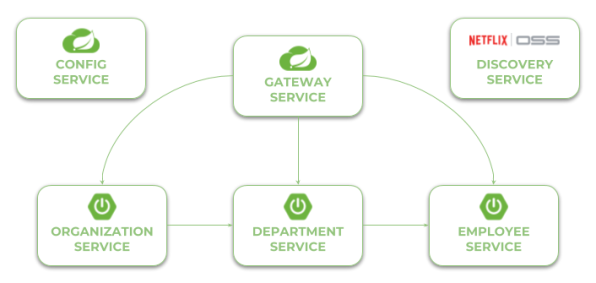
Currently, the newest version of Spring Cloud is Finchley.M9. This version of spring-cloud-dependencies should be declared as a BOM for dependency management.
<dependencyManagement> <dependencies> <dependency> <groupId>org.springframework.cloud</groupId> <artifactId>spring-cloud-dependencies</artifactId> <version>Finchley.M9</version> <type>pom</type> <scope>import</scope> </dependency> </dependencies> </dependencyManagement>
Now, let’s consider the further steps to be taken in order to create working microservices-based system using Spring Cloud. We will begin from Configuration Server.
The source code of sample applications presented in this article is available on GitHub in repository https://github.com/piomin/sample-spring-microservices-new.git.
Step 1. Building configuration server with Spring Cloud Config
To enable Spring Cloud Config feature for an application, first include spring-cloud-config-server to your project dependencies.
<dependency> <groupId>org.springframework.cloud</groupId> <artifactId>spring-cloud-config-server</artifactId> </dependency>
Then enable running embedded configuration server during application boot use @EnableConfigServer annotation.
@SpringBootApplication
@EnableConfigServer
public class ConfigApplication {
public static void main(String[] args) {
new SpringApplicationBuilder(ConfigApplication.class).run(args);
}
}
By default Spring Cloud Config Server store the configuration data inside Git repository. This is very good choice in production mode, but for the sample purpose file system backend will be enough. It is really easy to start with config server, because we can place all the properties in the classpath. Spring Cloud Config by default search for property sources inside the following locations: classpath:/, classpath:/config, file:./, file:./config.
We place all the property sources inside src/main/resources/config. The YAML filename will be the same as the name of service. For example, YAML file for discovery-service will be located here: src/main/resources/config/discovery-service.yml.
And last two important things. If you would like to start config server with file system backend you have activate Spring Boot profile native. It may be achieved by setting parameter --spring.profiles.active=native during application boot. I have also changed the default config server port (8888) to 8061 by setting property server.port in bootstrap.yml file.
Step 2. Building service discovery with Spring Cloud Netflix Eureka
More to the point of configuration server. Now, all other applications, including discovery-service, need to add spring-cloud-starter-config dependency in order to enable config client. We also have to include dependency to spring-cloud-starter-netflix-eureka-server.
<dependency> <groupId>org.springframework.cloud</groupId> <artifactId>spring-cloud-starter-netflix-eureka-server</artifactId> </dependency>
Then you should enable running embedded discovery server during application boot by setting @EnableEurekaServer annotation on the main class.
@SpringBootApplication
@EnableEurekaServer
public class DiscoveryApplication {
public static void main(String[] args) {
new SpringApplicationBuilder(DiscoveryApplication.class).run(args);
}
}
Application has to fetch property source from configuration server. The minimal configuration required on the client side is an application name and config server’s connection settings.
spring:
application:
name: discovery-service
cloud:
config:
uri: http://localhost:8088
As I have already mentioned, the configuration file discovery-service.yml should be placed inside config-service module. However, it is required to say a few words about the configuration visible below. We have changed Eureka running port from default value (8761) to 8061. For standalone Eureka instance we have to disable registration and fetching registry.
server:
port: 8061
eureka:
instance:
hostname: localhost
client:
registerWithEureka: false
fetchRegistry: false
serviceUrl:
defaultZone: http://${eureka.instance.hostname}:${server.port}/eureka/
Now, when you are starting your application with embedded Eureka server you should see the following logs.

Once you have succesfully started application you may visit Eureka Dashboard available under address http://localhost:8061/.
Step 3. Building microservice using Spring Boot and Spring Cloud
Our microservice has te perform some operations during boot. It needs to fetch configuration from config-service, register itself in discovery-service, expose HTTP API and automatically generate API documentation. To enable all these mechanisms we need to include some dependencies in pom.xml. To enable config client we should include starter spring-cloud-starter-config. Discovery client will be enabled for microservice after including spring-cloud-starter-netflix-eureka-client and annotating the main class with @EnableDiscoveryClient. To force Spring Boot application generating API documentation we should include springfox-swagger2 dependency and add annotation @EnableSwagger2.
Here is the full list of dependencies defined for my sample microservice.
<dependency> <groupId>org.springframework.cloud</groupId> <artifactId>spring-cloud-starter-netflix-eureka-client</artifactId> </dependency> <dependency> <groupId>org.springframework.cloud</groupId> <artifactId>spring-cloud-starter-config</artifactId> </dependency> <dependency> <groupId>org.springframework.boot</groupId> <artifactId>spring-boot-starter-web</artifactId> </dependency> <dependency> <groupId>io.springfox</groupId> <artifactId>springfox-swagger2</artifactId> <version>2.8.0</version> </dependency>
And here is the main class of application that enables Discovery Client and Swagger2 for the microservice.
@SpringBootApplication
@EnableDiscoveryClient
@EnableSwagger2
public class EmployeeApplication {
public static void main(String[] args) {
SpringApplication.run(EmployeeApplication.class, args);
}
@Bean
public Docket swaggerApi() {
return new Docket(DocumentationType.SWAGGER_2)
.select()
.apis(RequestHandlerSelectors.basePackage("pl.piomin.services.employee.controller"))
.paths(PathSelectors.any())
.build()
.apiInfo(new ApiInfoBuilder().version("1.0").title("Employee API").description("Documentation Employee API v1.0").build());
}
...
}
Application has to fetch configuration from a remote server, so we should only provide bootstrap.yml file with service name and server URL. In fact, this is the example of Config First Bootstrap approach, when an application first connects to a config server and takes a discovery server address from a remote property source. There is also Discovery First Bootstrap, where a config server address is fetched from a discovery server.
spring:
application:
name: employee-service
cloud:
config:
uri: http://localhost:8088
There is no much configuration settings. Here’s application’s configuration file stored on a remote server. It stores only HTTP running port and Eureka URL. However, I also placed file employee-service-instance2.yml on remote config server. It sets different HTTP port for application, so you can esily run two instances of the same service locally basing on remote properties. Now, you may run the second instance of employee-service on port 9090 after passing argument spring.profiles.active=instance2 during an application startup. With default settings you will start the microservice on port 8090.
server:
port: 9090
eureka:
client:
serviceUrl:
defaultZone: http://localhost:8061/eureka/
Here’s the code with implementation of REST controller class. It provides an implementation for adding new employee and searching for employee using different filters.
@RestController
public class EmployeeController {
private static final Logger LOGGER = LoggerFactory.getLogger(EmployeeController.class);
@Autowired
EmployeeRepository repository;
@PostMapping
public Employee add(@RequestBody Employee employee) {
LOGGER.info("Employee add: {}", employee);
return repository.add(employee);
}
@GetMapping("/{id}")
public Employee findById(@PathVariable("id") Long id) {
LOGGER.info("Employee find: id={}", id);
return repository.findById(id);
}
@GetMapping
public List findAll() {
LOGGER.info("Employee find");
return repository.findAll();
}
@GetMapping("/department/{departmentId}")
public List findByDepartment(@PathVariable("departmentId") Long departmentId) {
LOGGER.info("Employee find: departmentId={}", departmentId);
return repository.findByDepartment(departmentId);
}
@GetMapping("/organization/{organizationId}")
public List findByOrganization(@PathVariable("organizationId") Long organizationId) {
LOGGER.info("Employee find: organizationId={}", organizationId);
return repository.findByOrganization(organizationId);
}
}
Step 4. Communication between microservice with Spring Cloud Open Feign
Our first microservice has been created and started. Now, we will add other microservices that communicate with each other. The following diagram illustrates the communication flow between three sample microservices: organization-service, department-service and employee-service. Microservice organization-service collect list of departments with (GET /organization/{organizationId}/with-employees) or without employees (GET /organization/{organizationId}) from department-service, and list of employees without dividing them into different departments directly from employee-service. Microservice department-service is able to collect list of employees assigned to the particular department.
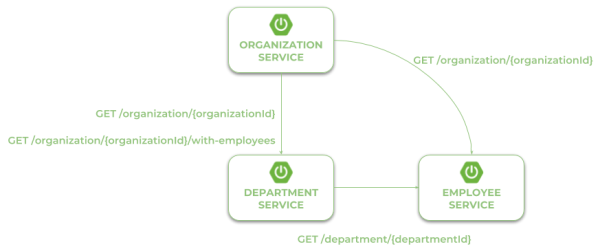
In the scenario described above both organization-service and department-service have to localize other microservices and communicate with them. That’s why we need to include additional dependency for those modules: spring-cloud-starter-openfeign. Spring Cloud Open Feign is a declarative REST client that used Ribbon client-side load balancer in order to communicate with other microservice.
<dependency> <groupId>org.springframework.cloud</groupId> <artifactId>spring-cloud-starter-openfeign</artifactId> </dependency>
The alternative solution to Open Feign is Spring RestTemplate with @LoadBalanced. However, Feign provides more ellegant way of defining client, so I prefer it instead of RestTemplate. After including the required dependency we should also enable Feign clients using @EnableFeignClients annotation.
@SpringBootApplication
@EnableDiscoveryClient
@EnableFeignClients
@EnableSwagger2
public class OrganizationApplication {
public static void main(String[] args) {
SpringApplication.run(OrganizationApplication.class, args);
}
...
}
Now, we need to define client’s interfaces. Because organization-service communicates with two other microservices we should create two interfaces, one per single microservice. Every client’s interface should be annotated with @FeignClient. One field inside annotation is required – name. This name should be the same as the name of target service registered in service discovery. Here’s the interface of the client that calls endpoint GET /organization/{organizationId} exposed by employee-service.
@FeignClient(name = "employee-service")
public interface EmployeeClient {
@GetMapping("/organization/{organizationId}")
List findByOrganization(@PathVariable("organizationId") Long organizationId);
}
The second client’s interface available inside organization-service calls two endpoints from department-service. First of them GET /organization/{organizationId} returns organization only with the list of available departments, while the second GET /organization/{organizationId}/with-employees return the same set of data including the list employees assigned to every department.
@FeignClient(name = "department-service")
public interface DepartmentClient {
@GetMapping("/organization/{organizationId}")
public List findByOrganization(@PathVariable("organizationId") Long organizationId);
@GetMapping("/organization/{organizationId}/with-employees")
public List findByOrganizationWithEmployees(@PathVariable("organizationId") Long organizationId);
}
Finally, we have to inject Feign client’s beans to the REST controller. Now, we may call the methods defined inside DepartmentClient and EmployeeClient, which is equivalent to calling REST endpoints.
@RestController
public class OrganizationController {
private static final Logger LOGGER = LoggerFactory.getLogger(OrganizationController.class);
@Autowired
OrganizationRepository repository;
@Autowired
DepartmentClient departmentClient;
@Autowired
EmployeeClient employeeClient;
...
@GetMapping("/{id}")
public Organization findById(@PathVariable("id") Long id) {
LOGGER.info("Organization find: id={}", id);
return repository.findById(id);
}
@GetMapping("/{id}/with-departments")
public Organization findByIdWithDepartments(@PathVariable("id") Long id) {
LOGGER.info("Organization find: id={}", id);
Organization organization = repository.findById(id);
organization.setDepartments(departmentClient.findByOrganization(organization.getId()));
return organization;
}
@GetMapping("/{id}/with-departments-and-employees")
public Organization findByIdWithDepartmentsAndEmployees(@PathVariable("id") Long id) {
LOGGER.info("Organization find: id={}", id);
Organization organization = repository.findById(id);
organization.setDepartments(departmentClient.findByOrganizationWithEmployees(organization.getId()));
return organization;
}
@GetMapping("/{id}/with-employees")
public Organization findByIdWithEmployees(@PathVariable("id") Long id) {
LOGGER.info("Organization find: id={}", id);
Organization organization = repository.findById(id);
organization.setEmployees(employeeClient.findByOrganization(organization.getId()));
return organization;
}
}
Step 5. Building API gateway using Spring Cloud Gateway
Spring Cloud Gateway is relatively new Spring Cloud project. It is built on top of Spring Framework 5, Project Reactor and Spring Boot 2.0. It requires the Netty runtime provided by Spring Boot and Spring Webflux. This is really nice alternative to Spring Cloud Netflix Zuul, which has been the only one Spring Cloud project providing API gateway for microservices until now.
API gateway is implemented inside module gateway-service. First, we should include starter spring-cloud-starter-gateway to the project dependencies.
<dependency> <groupId>org.springframework.cloud</groupId> <artifactId>spring-cloud-starter-gateway</artifactId> </dependency>
We also need to have discovery client enabled, because gateway-service integrates with Eureka in order to be able to perform routing to the downstream services. Gateway will also expose API specification of all the endpoints exposed by our sample microservices. That’s why we enabled Swagger2 also on the gateway.
@SpringBootApplication
@EnableDiscoveryClient
@EnableSwagger2
public class GatewayApplication {
public static void main(String[] args) {
SpringApplication.run(GatewayApplication.class, args);
}
}
Spring Cloud Gateway provides three basic components used for configuration: routes, predicates and filters. Route is the basic building block of the gateway. It contains destination URI and list of defined predicates and filters. Predicate is responsible for matching on anything from the incoming HTTP request, such as headers or parameters. Filter may modify request and response before and after sending it to downstream services. All these components may be set using configuration properties. We will create and place on the confiration server file gateway-service.yml with the routes defined for our sample microservices.
But first, we should enable integration with discovery server for the routes by setting property spring.cloud.gateway.discovery.locator.enabled to true. Then we may proceed to defining the route rules. We use the Path Route Predicate Factory for matching the incoming requests, and the RewritePath GatewayFilter Factory for modifying the requested path to adapt it to the format exposed by downstream services. The uri parameter specifies the name of target service registered in discovery server. Let’s take a look on the following routes definition. For example, in order to make organization-service available on gateway under path /organization/**, we should define predicate Path=/organization/**, and then strip prefix /organization from the path, because the target service is exposed under path /**. The address of target service is fetched for Eureka basing uri value lb://organization-service.
spring:
cloud:
gateway:
discovery:
locator:
enabled: true
routes:
- id: employee-service
uri: lb://employee-service
predicates:
- Path=/employee/**
filters:
- RewritePath=/employee/(?.*), /$\{path}
- id: department-service
uri: lb://department-service
predicates:
- Path=/department/**
filters:
- RewritePath=/department/(?.*), /$\{path}
- id: organization-service
uri: lb://organization-service
predicates:
- Path=/organization/**
filters:
- RewritePath=/organization/(?.*), /$\{path}
Step 6. Enabling API specification on gateway using Swagger2
Every Spring Boot microservice that is annotated with @EnableSwagger2 exposes Swagger API documentation under path /v2/api-docs. However, we would like to have that documentation located in the single place – on API gateway. To achieve it we need to provide bean implementing SwaggerResourcesProvider interface inside gateway-service module. That bean is responsible for defining list storing locations of Swagger resources, which should be displayed by the application. Here’s the implementation of SwaggerResourcesProvider that takes the required locations from service discovery basing on the Spring Cloud Gateway configuration properties.
Unfortunately, SpringFox Swagger still does not provide support for Spring WebFlux. It means that if you include SpringFox Swagger dependencies to the project application will fail to start… I hope the support for WebFlux will be available soon, but now we have to use Spring Cloud Netflix Zuul as a gateway, if we would like to run embedded Swagger2 on it.
I created module proxy-service that is an alternative API gateway based on Netflix Zuul to gateway-service based on Spring Cloud Gateway. Here’s a bean with SwaggerResourcesProvider implementation available inside proxy-service. It uses ZuulProperties bean to dynamically load routes definition into the bean.
@Configuration
public class ProxyApi {
@Autowired
ZuulProperties properties;
@Primary
@Bean
public SwaggerResourcesProvider swaggerResourcesProvider() {
return () -> {
List resources = new ArrayList();
properties.getRoutes().values().stream()
.forEach(route -> resources.add(createResource(route.getServiceId(), route.getId(), "2.0")));
return resources;
};
}
private SwaggerResource createResource(String name, String location, String version) {
SwaggerResource swaggerResource = new SwaggerResource();
swaggerResource.setName(name);
swaggerResource.setLocation("/" + location + "/v2/api-docs");
swaggerResource.setSwaggerVersion(version);
return swaggerResource;
}
}
Here’s Swagger UI for our sample microservices system available under address http://localhost:8060/swagger-ui.html.
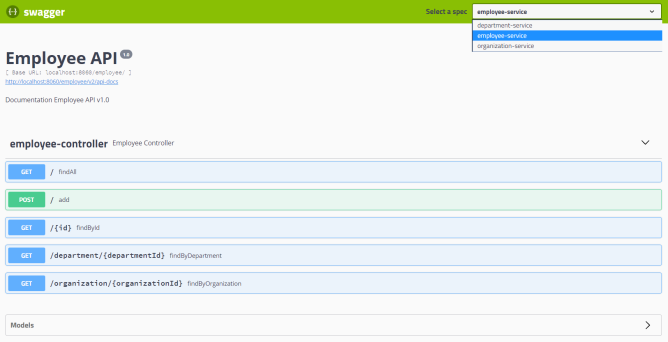
Step 7. Running applications
Let’s take a look on the architecture of our system visible on the following diagram. We will discuss it from the organization-service point of view. After starting organization-service connects to config-service available under address localhost:8088 (1). Basing on remote configuration settings it is able to register itself in Eureka (2). When the endpoint of organization-service is invoked by external client via gateway (3) available under address localhost:8060, the request is forwarded to instance of organization-service basing on entries from service discovery (4). Then organization-service lookup for address of department-service in Eureka (5), and call its endpoint (6). Finally department-service calls endpont from employee-service. The request as load balanced between two available instance of employee-service by Ribbon (7).
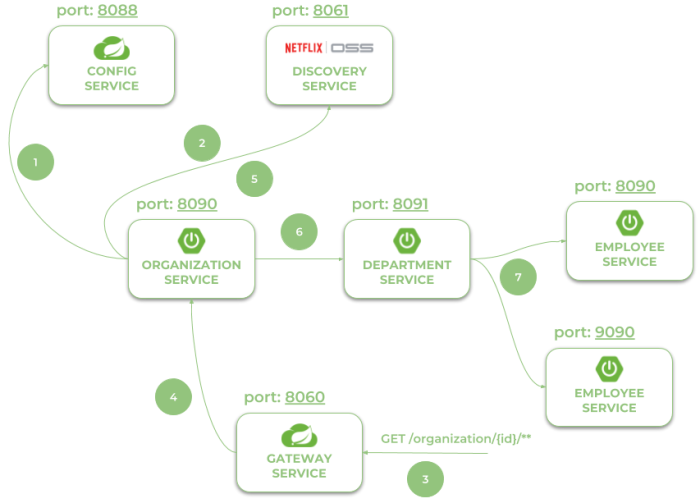
Let’s take a look on the Eureka Dashboard available under address http://localhost:8061. There are four instances of microservices registered there: a single instance of organization-service and department-service, and two instances of employee-service.

Now, let’s call endpoint http://localhost:8060/organization/1/with-departments-and-employees.
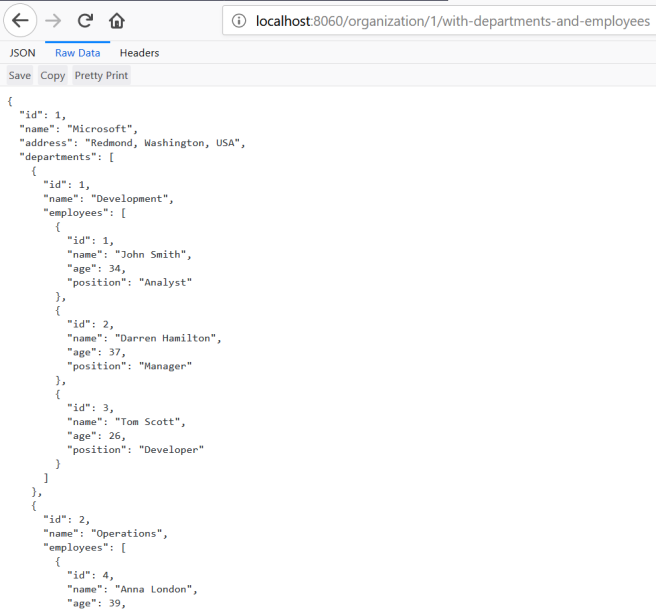
Step 8. Correlating logs between independent microservices using Spring Cloud Sleuth
Correlating logs between different microservice using Spring Cloud Sleuth is very easy. In fact, the only thing you have to do is to add starter spring-cloud-starter-sleuth to the dependencies of every single microservice and gateway.
<dependency> <groupId>org.springframework.cloud</groupId> <artifactId>spring-cloud-starter-sleuth</artifactId> </dependency>
For clarification we will change default log format a little to: %d{yyyy-MM-dd HH:mm:ss} ${LOG_LEVEL_PATTERN:-%5p} %m%n. Here are the logs generated by our three sample miccroservices. There are four entries inside braces [] generated by Spring Cloud Stream. The most important for us is the second entry, which indicates on traceId, that is set once per incoming HTTP request on the edge of the system.



Versioning REST API with Spring Boot and Swagger
One thing’s for sure. If you don’t have to version your API, do not try to do that. However, sometimes you have to. A large part of the most popular services like Twitter, Facebook, Netflix or PayPal is versioning their REST APIs. The advantages and disadvantages of that approach are obvious. On the one hand you don’t have to worry about making changes in your API even if many external clients and applications consume it. But on the other hand, you have maintain different versions of API implementation in your code, what sometimes may be troublesome.
In this article I’m going to show you how to maintain the several versions of REST API in your application in the most comfortable way. We will base on the sample application written on the top of Spring Boot framework and exposing API documentation using Swagger and SpringFox libraries.
Spring Boot does not provide any dedicated solutions for versioning APIs. The situation is different for SpringFox Swagger2 library, which provides grouping mechanism from version 2.8.0, which is perfect for generating documentation of versioned REST API.
I have already introduced Swagger2 together with Spring Boot application in one of my previous posts. In the article Microservices API Documentation with Swagger2 you may read how to use Swagger2 for generating API documentation for all the independent microservices and publishing it in one place – on API Gateway.
Different approaches to API versioning
There are some different ways to provide an API versioning in your application. The most popular of them are:
- Through an URI path – you include the version number in the URL path of the endpoint, for example /api/v1/persons
- Through query parameters – you pass the version number as a query parameter with specified name, for example /api/persons?version=1
- Through custom HTTP headers – you define a new header that contains the version number in the request
- Through a content negotiation – the version number is included to the “Accept” header together with accepted content type. The request with cURL would look like in the following sample:
curl -H "Accept: application/vnd.piomin.v1+json" http://localhost:8080/api/persons
The decision, which of that approach implement in the application is up to you. We would discuss the advantages and disadvantages of every single approach, however it is not the main purpose of that article. The main purpose is to show you how to implement versioning in Spring Boot application and then publish the API documentation automatically using Swagger2. The sample application source code is available on GitHub (https://github.com/piomin/sample-api-versioning.git). I have implemented two of the approaches described above – in point 1 and 4.
Enabling Swagger for Spring Boot
Swagger2 can be enabled in Spring Boot application by including SpringFox library. In fact, this is the suite of java libraries used for automating the generation of machine and human readable specifications for JSON APIs written using Spring Framework. It supports such formats like swagger, RAML and jsonapi. To enable it for your application include the following Maven dependencies to the project: io.springfox:springfox-swagger-ui, io.springfox:springfox-swagger2, io.springfox:springfox-spring-web. Then you will have to annotate the main class with @EnableSwagger2 and define Docker object. Docket is a Springfox’s primary configuration mechanism for Swagger 2.0. We will discuss the details about it in the next section along with the sample for each way of versioning API.
Sample API
Our sample API is very simple. It exposes basic CRUD methods for Person entity. There are three versions of API available for external clients: 1.0, 1.1 and 1.2. In the version 1.1 I have changed the method for updating Person entity. In version 1.0 it was available under /person path, while now it is available under /person/{id} path. This is the only difference between versions 1.0 and 1.1. There is also one only difference in API between versions 1.1 and 1.2. Instead of field birthDate it returns age as integer parameter. This change affects to all the endpoints except DELETE /person/{id}. Now, let’s proceed to the implementation.
Versioning using URI path
Here’s the full implementation of URI path versioning inside Spring @RestController.
@RestController
@RequestMapping("/person")
public class PersonController {
@Autowired
PersonMapper mapper;
@Autowired
PersonRepository repository;
@PostMapping({"/v1.0", "/v1.1"})
public PersonOld add(@RequestBody PersonOld person) {
return (PersonOld) repository.add(person);
}
@PostMapping("/v1.2")
public PersonCurrent add(@RequestBody PersonCurrent person) {
return mapper.map((PersonOld) repository.add(person));
}
@PutMapping("/v1.0")
@Deprecated
public PersonOld update(@RequestBody PersonOld person) {
return (PersonOld) repository.update(person);
}
@PutMapping("/v1.1/{id}")
public PersonOld update(@PathVariable("id") Long id, @RequestBody PersonOld person) {
return (PersonOld) repository.update(person);
}
@PutMapping("/v1.2/{id}")
public PersonCurrent update(@PathVariable("id") Long id, @RequestBody PersonCurrent person) {
return mapper.map((PersonOld) repository.update(person));
}
@GetMapping({"/v1.0/{id}", "/v1.1/{id}"})
public PersonOld findByIdOld(@PathVariable("id") Long id) {
return (PersonOld) repository.findById(id);
}
@GetMapping("/v1.2/{id}")
public PersonCurrent findById(@PathVariable("id") Long id) {
return mapper.map((PersonOld) repository.findById(id));
}
@DeleteMapping({"/v1.0/{id}", "/v1.1/{id}", "/v1.2/{id}"})
public void delete(@PathVariable("id") Long id) {
repository.delete(id);
}
}
If you would like to have three different versions available in the single generated API specification you should declare three Docket @Beans – one per single version. In this case the swagger group concept, which has been already introduced by SpringFox, would be helpful for us. The reason this concept bas been introduced is a necessity for support applications which require more than one swagger resource listing. Usually you need more than one resource listing in order to provide different versions of the same API. We can assign group to every Docket just by invoking groupName DSL method on it. Because different versions of API method are implemented within the same controller, we have to distinguish them by declaring path regex matching the selected version. All other settings are standard.
@Bean
public Docket swaggerPersonApi10() {
return new Docket(DocumentationType.SWAGGER_2)
.groupName("person-api-1.0")
.select()
.apis(RequestHandlerSelectors.basePackage("pl.piomin.services.versioning.controller"))
.paths(regex("/person/v1.0.*"))
.build()
.apiInfo(new ApiInfoBuilder().version("1.0").title("Person API").description("Documentation Person API v1.0").build());
}
@Bean
public Docket swaggerPersonApi11() {
return new Docket(DocumentationType.SWAGGER_2)
.groupName("person-api-1.1")
.select()
.apis(RequestHandlerSelectors.basePackage("pl.piomin.services.versioning.controller"))
.paths(regex("/person/v1.1.*"))
.build()
.apiInfo(new ApiInfoBuilder().version("1.1").title("Person API").description("Documentation Person API v1.1").build());
}
@Bean
public Docket swaggerPersonApi12() {
return new Docket(DocumentationType.SWAGGER_2)
.groupName("person-api-1.2")
.select()
.apis(RequestHandlerSelectors.basePackage("pl.piomin.services.versioning.controller"))
.paths(regex("/person/v1.2.*"))
.build()
.apiInfo(new ApiInfoBuilder().version("1.2").title("Person API").description("Documentation Person API v1.2").build());
}
Now, we may display Swagger UI for our API just by calling URL in the web browser path /swagger-ui.html. You can switch between all available versions of API as you can see on the picture below.

Specification is generated by the exact version of API. Here’s documentation for version 1.0. Because method PUT /person is annotated with @Deprecated it is crossed out on the generated HTML documentation page.

If you switch to group person-api-1 you will see all the methods that contains v1.1 in the path. Along them you may recognize the current version of PUT method with {id} field in the path.

When using documentation generated by Swagger you may easily call every method after expanding it. Here’s the sample of calling method PUT /person/{id} from implemented for version 1.2.

Versioning using ‘Accept’ header
To access the implementation of versioning witt ‘Accept’ header you should switch to branch header (https://github.com/piomin/sample-api-versioning/tree/header). Here’s the full implementation of content negotiation using ‘Accept’ header versioning inside Spring @RestController.
@RestController
@RequestMapping("/person")
public class PersonController {
@Autowired
PersonMapper mapper;
@Autowired
PersonRepository repository;
@PostMapping(produces = {"application/vnd.piomin.app-v1.0+json", "application/vnd.piomin.app-v1.1+json"})
public PersonOld add(@RequestBody PersonOld person) {
return (PersonOld) repository.add(person);
}
@PostMapping(produces = "application/vnd.piomin.app-v1.2+json")
public PersonCurrent add(@RequestBody PersonCurrent person) {
return mapper.map((PersonOld) repository.add(person));
}
@PutMapping(produces = "application/vnd.piomin.app-v1.0+json")
@Deprecated
public PersonOld update(@RequestBody PersonOld person) {
return (PersonOld) repository.update(person);
}
@PutMapping(value = "/{id}", produces = "application/vnd.piomin.app-v1.1+json")
public PersonOld update(@PathVariable("id") Long id, @RequestBody PersonOld person) {
return (PersonOld) repository.update(person);
}
@PutMapping(value = "/{id}", produces = "application/vnd.piomin.app-v1.2+json")
public PersonCurrent update(@PathVariable("id") Long id, @RequestBody PersonCurrent person) {
return mapper.map((PersonOld) repository.update(person));
}
@GetMapping(name = "findByIdOld", value = "/{idOld}", produces = {"application/vnd.piomin.app-v1.0+json", "application/vnd.piomin.app-v1.1+json"})
@Deprecated
public PersonOld findByIdOld(@PathVariable("idOld") Long id) {
return (PersonOld) repository.findById(id);
}
@GetMapping(name = "findById", value = "/{id}", produces = "application/vnd.piomin.app-v1.2+json")
public PersonCurrent findById(@PathVariable("id") Long id) {
return mapper.map((PersonOld) repository.findById(id));
}
@DeleteMapping(value = "/{id}", produces = {"application/vnd.piomin.app-v1.0+json", "application/vnd.piomin.app-v1.1+json", "application/vnd.piomin.app-v1.2+json"})
public void delete(@PathVariable("id") Long id) {
repository.delete(id);
}
}
We still have to define three Docker @Beans, but the filtering criterias are slightly different. The simple filtering by path is not an option here. We have to crate Predicate for RequestHandler object and pass it to apis DSL method. The predicate implementation should filter every method in order to find only those which have produces field with required version number. Here’s sample Docket implementation for version 1.2.
@Bean
public Docket swaggerPersonApi12() {
return new Docket(DocumentationType.SWAGGER_2)
.groupName("person-api-1.2")
.select()
.apis(p -> {
if (p.produces() != null) {
for (MediaType mt : p.produces()) {
if (mt.toString().equals("application/vnd.piomin.app-v1.2+json")) {
return true;
}
}
}
return false;
})
.build()
.produces(Collections.singleton("application/vnd.piomin.app-v1.2+json"))
.apiInfo(new ApiInfoBuilder().version("1.2").title("Person API").description("Documentation Person API v1.2").build());
}
As you can see on the picture below the generated methods does not have the version number in the path.

When calling method for the selected version of API the only difference is in the response’s required content type.

Summary
Versioning is one of the most important concept around HTTP APIs designing. No matter which approach to versioning you choose you should do everything to describe your API well. This seems to be especially important in the era of microservices, where your interface may be called by many other independent applications. In this case creating documentation in isolation from the source code could be troublesome. Swagger solves all of described problems. It may be easily integrated with your application, supports versioning. Thanks to SpringFox project it also can be easily customized in your Spring Boot application to meet more advanced demands.
Microservices API Documentation with Swagger2
Swagger is the most popular tool for designing, building and documenting RESTful APIs. It has nice integration with Spring Boot. To use it in conjunction with Spring we need to add following two dependencies to Maven pom.xml.
<dependency> <groupId>io.springfox</groupId> <artifactId>springfox-swagger2</artifactId> <version>2.6.1</version> </dependency> <dependency> <groupId>io.springfox</groupId> <artifactId>springfox-swagger-ui</artifactId> <version>2.6.1</version> </dependency>
Swagger configuration for single Spring Boot service is pretty simple. The level of complexity is greater if you want to create one documentation for several separated microservices. Such documentation should be available on API gateway. In the picture below you can see the architecture of our sample solution.
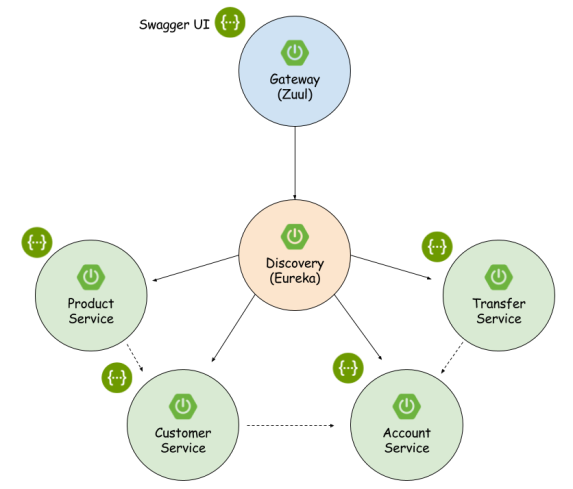
First, we should configure Swagger on every microservice. To enable it we have to declare @EnableSwagger2 on the main class. API documentation will be automatically generated from source code by Swagger library during application startup. The process is controlled by Docket @Bean which is also declared in the main class. API version is read from pom.xml file using MavenXpp3Reader. We also set some other properties like title, author and description using apiInfo method. By default, Swagger generates documentation for all REST services including those created by Spring Boot. We would like to limit documentation only to our @RestController located inside pl.piomin.microservices.advanced.account.api package.
@Bean
public Docket api() throws IOException, XmlPullParserException {
MavenXpp3Reader reader = new MavenXpp3Reader();
Model model = reader.read(new FileReader("pom.xml"));
return new Docket(DocumentationType.SWAGGER_2)
.select()
.apis(RequestHandlerSelectors.basePackage("pl.piomin.microservices.advanced.account.api"))
.paths(PathSelectors.any())
.build().apiInfo(new ApiInfo("Account Service Api Documentation", "Documentation automatically generated", model.getParent().getVersion(), null, new Contact("Piotr Mińkowski", "piotrminkowski.wordpress.com", "piotr.minkowski@gmail.com"), null, null));
}
Here’s our API RESTful controller.
@RestController
public class AccountController {
@Autowired
AccountRepository repository;
protected Logger logger = Logger.getLogger(AccountController.class.getName());
@RequestMapping(value = "/accounts/{number}", method = RequestMethod.GET)
public Account findByNumber(@PathVariable("number") String number) {
logger.info(String.format("Account.findByNumber(%s)", number));
return repository.findByNumber(number);
}
@RequestMapping(value = "/accounts/customer/{customer}", method = RequestMethod.GET)
public List findByCustomer(@PathVariable("customer") String customerId) {
logger.info(String.format("Account.findByCustomer(%s)", customerId));
return repository.findByCustomerId(customerId);
}
@RequestMapping(value = "/accounts", method = RequestMethod.GET)
public List findAll() {
logger.info("Account.findAll()");
return repository.findAll();
}
@RequestMapping(value = "/accounts", method = RequestMethod.POST)
public Account add(@RequestBody Account account) {
logger.info(String.format("Account.add(%s)", account));
return repository.save(account);
}
@RequestMapping(value = "/accounts", method = RequestMethod.PUT)
public Account update(@RequestBody Account account) {
logger.info(String.format("Account.update(%s)", account));
return repository.save(account);
}
}
The similar Swagger’s configuration exists on every microservice. API documentation is available under http://localhost:/swagger-ui.html. Now, we would like to enable one documentation embedded on the gateway for all microservices. Here’s Spring @Component implementing SwaggerResourcesProvider interface which overrides default provider configuration exists in Spring context.
@Component
@Primary
@EnableAutoConfiguration
public class DocumentationController implements SwaggerResourcesProvider {
@Override
public List get() {
List resources = new ArrayList<>();
resources.add(swaggerResource("account-service", "/api/account/v2/api-docs", "2.0"));
resources.add(swaggerResource("customer-service", "/api/customer/v2/api-docs", "2.0"));
resources.add(swaggerResource("product-service", "/api/product/v2/api-docs", "2.0"));
resources.add(swaggerResource("transfer-service", "/api/transfer/v2/api-docs", "2.0"));
return resources;
}
private SwaggerResource swaggerResource(String name, String location, String version) {
SwaggerResource swaggerResource = new SwaggerResource();
swaggerResource.setName(name);
swaggerResource.setLocation(location);
swaggerResource.setSwaggerVersion(version);
return swaggerResource;
}
}
All microservices api-docs are added as Swagger resources. The location address is proxied via Zuul gateway. Here’s gateway route configuration.
zuul:
prefix: /api
routes:
account:
path: /account/**
serviceId: account-service
customer:
path: /customer/**
serviceId: customer-service
product:
path: /product/**
serviceId: product-service
transfer:
path: /transfer/**
serviceId: transfer-service
Now, API documentation is available under gateway address http://localhost:8765/swagger-ui.html. You can see how it looks for account service in the picture below. We can select source service in the combo box placed inside title panel.

Documentation appearence can be easily customized by providing UIConfiguration @Bean. In the code below I changed default operations expansion level by setting “list” as a second constructor parameter – docExpansion.
@Bean
UiConfiguration uiConfig() {
return new UiConfiguration("validatorUrl", "list", "alpha", "schema",
UiConfiguration.Constants.DEFAULT_SUBMIT_METHODS, false, true, 60000L);
}
You can expand every operation to see the details. Every operation can be test by providing required parameters and clicking Try it out! button.


Sample application source code is available on GitHub.




